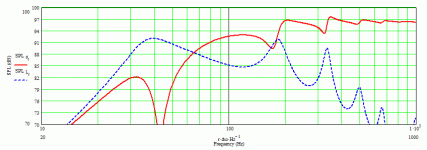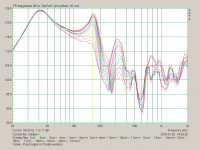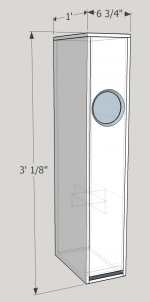You're welcome!
Well, way back in my building 'career', I mostly had no T/S, just Fs and published nomographs based on high output impedance amps and an Fb = Fs, so were 'fatter' than the later high output impedance + T/S specs, which pares off any excess cab volume [Vb].
Effective piston area [Sd] was fixed based on frame size and never used for other than determining vent area [Av].
The common box ratio was 1.0:2^0.5 [~1.414]:2.0, so for 'column'/'tower' alignments I calculated a box, then used its CSA for the taller one and whatever its Vb was I didn't care, just tuned it to be flat/whatever, then used the 'click' test to critically damp it to remove any 'ringing'/'overshoot':
Click Test | GM210 | Flickr
For 23.8 L = 23,800 cm^3:
23800^[1/3] = ~28.76 cm = width
depth = ~28.76/2^0.5 = ~20.34 cm
height = ~20.34*2 = ~40.68 cm
Which sums a little low at ~23,797 cm^3, so if used in the future may/may not want to round it up higher.
We only want ~28.76*20.34 = ~585 cm^2 = ~4.1x Sd is what I would have actually used, though again, this factors in using a SET or similar output impedance amp, but then I'd rather have too much than too little net [Vb] for in room 'voicing' than be left 'wanting'.
Once a T/S vented alignment routine for the masses came along I started simming to achieve a +3 dB/Fb peak for low and +6 dB for high output impedance and it was what it was, so try these to see if any of it suits you or at least gives you a range.
GM
edit: ...the later low output impedance + T/S specs.......
GM
Then why refer to it at all? It is irrelevant.
I'm afraid that you do not get to dictate what people on this forum do. You are the one asking about 'unexpected results'. If you do not wish to learn, I suggest you do not ask questions.
You can use any of the many pieces of software out there to obtain a volume: WinISD is merely one which can provide such default options (along with freedom of adjustability), to which you can add Boxsim, VituixCAD, LspCAD, Winspeakerz, Unibox, Woofer box & Circuit Designer, BassBox in its many variations, Basta, AJhorn, Vented-FDD... the list could continue for quite some time. The aforementioned software does not 'verify AMLTL principle' however; it just provides a quick & convenient way of getting a box volume & vent dimensions to use in the proportions X recommends in this thread. You can always do it longhand if you prefer. For example, Small's maximally-flat vented alignment takes box volume as 20Vas*Qt^3.3 and box tuning frequency as 0.42Fs*Qt^-0.96.
Nobody said your assumtion was out of topic. What I have endevoured to explain is that it is mistaken. TABAQ's volume has nothing to do with a standard Helmholtz vented box alignment such as the default examples provided by WinISD, so by definition they do not match (except by accident on rare occasions).
...So, did you tried AMLTL technique?
As noted, X has created the AMLTL as a simple design method for people who are not in the position to create custom designs to their own requirements. It works fine & is very useful within that context, but in itself it doesn't offer any scope for analysis or refinement, or hit any given alignment (because it wasn't designed to). So I do not use it myself: I prefer to use one of my custom alignments, and / or QW modelling in order to achieve a specific acoustic result, while acknowledging its use for those who are not in that position.
Last edited:
I expect them to be fine in a mltlAs noted, X has created the AMLTL as a simple design method for people who are not in the position to create custom designs to their own requirements. It works fine & is very useful within that context, but in itself it doesn't offer any scope for analysis or refinement, or hit any given alignment (because it wasn't designed to). So I do not use it myself: I prefer to use one of my custom alignments, and / or QW modelling in order to achieve a specific acoustic result, while acknowledging its use for those who are not in that position.
I have 8x Seas W12CY001 (excel) that I would like to try in a slim tower, would they work in MLTL since Qts = 0.36 and also not a full range?
Any drive unit that is suitable for vented box loading will work fine in an ML quarter-wave. In 'real' MLTLs it's merely a difference in loading type -QW as opposed to Helmholtz. In the majority (99.99%) it's more a case of accounting for the longitudinal eigenmode in the alignment (not quite the same thing). So yes, they do.
I think you are rightI think you might have quoted the wrong post.
so 4 per box?I have 8x Seas W12CY001 (excel) that I would like to try in a slim tower, would they work in MLTL since Qts = 0.36 and also not a full range?
if you place them so that the lower is at slightly below halfway top-bottom and the other 3 above then the worst unwanted resonances will be suppressed.
attached gif showing the effect of driver position (sim is for 1 driver only)
the graph shows actual measurements of port output of a MLTL with 2 drivers (d'A config) where I moved the baffle down 1cm at a time to find the optimum position.
Attachments
so 4 per box?
if you place them so that the lower is at slightly below halfway top-bottom and the other 3 above then the worst unwanted resonances will be suppressed.
attached gif showing the effect of driver position (sim is for 1 driver only)
the graph shows actual measurements of port output of a MLTL with 2 drivers (d'A config) where I moved the baffle down 1cm at a time to find the optimum position.
Thanks, this is the thread with design sketches:
Slim tower with dual Excel W12CY001
Sorry to reply to an old thread. I only just found the AMLTL technique while reading up on the TABAQ.
Another recent discovery for me is the Visaton FR13-4 5" full-range with whizzer cone. It's an inexpensive driver with high Qts (1.25), so I thought I'd plug it in to WinISD and then try the AMLTL technique with it. I settled on 1.3-ft3 volume; the port is 3.14-in2 cross-section area and 1.6-in long. The tuning frequency is 46Hz and -3dB occurs at 40Hz in a vented box.
Attached is my resulting AMLTL design. It's a practical size for my listening/living room.
I have a couple of questions. First, I notice that MLTLs often have a relatively square cross section, whereas mine is distinctly rectangular. Is that a problem? Secondly, for a 5" driver, am I better off using a proven design like the TABAQ large (which is taller than I would like)?
Thanks for any and all feedback.
Another recent discovery for me is the Visaton FR13-4 5" full-range with whizzer cone. It's an inexpensive driver with high Qts (1.25), so I thought I'd plug it in to WinISD and then try the AMLTL technique with it. I settled on 1.3-ft3 volume; the port is 3.14-in2 cross-section area and 1.6-in long. The tuning frequency is 46Hz and -3dB occurs at 40Hz in a vented box.
Attached is my resulting AMLTL design. It's a practical size for my listening/living room.
I have a couple of questions. First, I notice that MLTLs often have a relatively square cross section, whereas mine is distinctly rectangular. Is that a problem? Secondly, for a 5" driver, am I better off using a proven design like the TABAQ large (which is taller than I would like)?
Thanks for any and all feedback.
Attachments
For what it's worth lads (and this applies equally to a regular vented box, and perhaps most especially to Onken variations), remember that a vent duct is a 1/2 wave resonator. It has its own fundamental and harmonic structure, so the longer you go, the lower in frequency it is and generally speaking the more likely it is to cause issues / be audibly excited. My own ROT is that I won't use a regular vent of > 6in. That's my limit, and I would rather not go to that if possible. YMMV as always, but the less forcing you can use, so much the better.
I have a couple of questions. First, I notice that MLTLs often have a relatively square cross section, whereas mine is distinctly rectangular. Is that a problem? Secondly, for a 5" driver, am I better off using a proven design like the TABAQ large (which is taller than I would like)?
Rectangular cross section is fine and probably better than square. Keeping the port shorter vs longer is a good idea to avoid harmonics of 1/2-wave resonator as Scott points out.
A higher Qts driver might work - it will have a bass peak overshoot probably but that can sometimes be tamed with more stuffing. But best to spend a little more money on a driver with bigger magnet than waste a lot of money on wood making the wrong cabinet.
- Home
- Loudspeakers
- Full Range
- Accidental MLTL Technique


